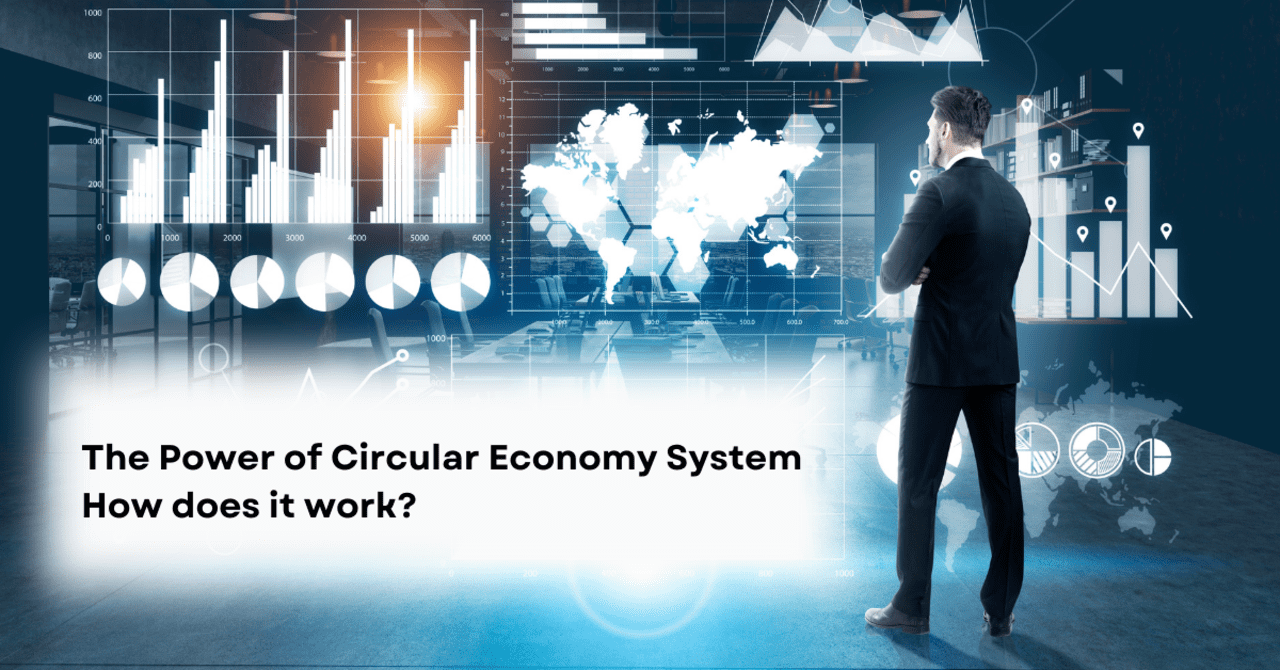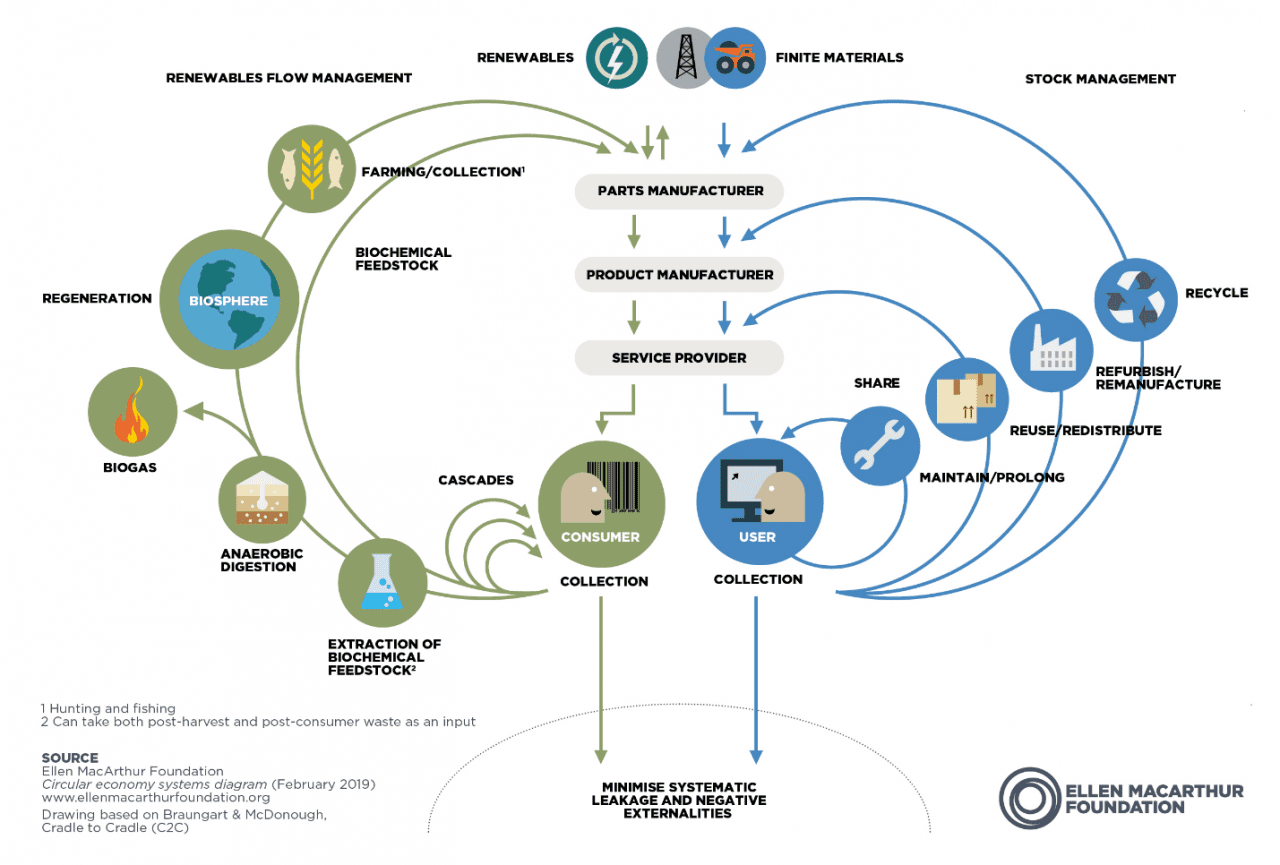The Power of Circular Economy System: How does it work?

Consider this: a forest's vitality relies on the presence of animals and microorganisms. Trees, animals, plants, and conifers are intricately interconnected, with the well-being of one organism influencing others in a mutually dependent cycle. If a link in this chain is severed, the entire cycle is disrupted.
Similarly, our society, environment, and economy function as the fundamental pillars that sustain our world. These three factors are of utmost importance for the smooth operation of our planet. However, should the environment suffer severe damage—an indispensable link in the chain of life—humankind would find itself on the brink of extinction.
Hence, it is crucial to manage the economy in a manner that minimizes its impact on other factors. The solution to this challenge lies in embracing the concept of the "Circular Economy System"
1. What is the Circular Economy System?
The circular economy system is an economic system aimed at minimizing waste and maximizing the use of resources. It is different from the traditional linear economy, which follows a "take-make-dispose" model, where resources are extracted, transformed into products, and eventually discarded as waste.
In a circular economy, the goal is to keep resources in use for as long as possible, extracting their maximum value before recovering and regenerating products and materials at the end of their useful life.
2. Why is it important to promote a circular economy system?
As previously mentioned, the circular economy system presents a solution to rectify the deficiencies of our existing linear economy, which often disregards environmental considerations and excessively exploits finite resources.
Therefore, promoting the circular economy system is essential for several reasons:
Resource Conservation: The circular economy system reduces reliance on finite resources by maximizing their use and minimizing waste generation. It promotes strategies like recycling, reusing, and refurbishing, which help conserve resources and reduce the need for raw material extraction.
Environmental Protection: By minimizing waste, pollution, and the extraction of virgin resources, the circular economy mitigates environmental impacts. It helps address issues such as climate change, deforestation, and ecosystem degradation, leading to a more sustainable and resilient planet.
Economic Benefits: Circular economy system practices can stimulate economic growth by creating new business opportunities and jobs. Repair services, recycling facilities, and remanufacturing industries can thrive, generating economic value and supporting local communities.
Energy Efficiency: The circular economy system emphasizes energy efficiency throughout the product lifecycle. It encourages the use of renewable energy sources, promotes energy-efficient technologies, and reduces energy-intensive processes. This helps in conserving energy and reducing greenhouse gas emissions.
Consumer Engagement: The circular economy involves consumers in sustainable consumption patterns. It encourages product durability, repairability, and reuse, empowering individuals to make informed choices that align with environmental values. This promotes a shift towards more conscious and responsible consumer behavior.
Resilience and Risk Mitigation: By reducing dependence on scarce resources and diversifying supply chains, the circular economy system enhances resilience to potential disruptions in resource availability or price fluctuations. It helps mitigate risks associated with resource scarcity and fosters a more stable and secure economy.
Long-Term Sustainability: The circular economy aligns with the principles of sustainable development, meeting the needs of the present without compromising the ability of future generations to meet their own needs. It offers a systemic approach to ensure a sustainable and equitable future for all.
3. How can we do to become the circular economy

Transition fully to a circular economy system is a challenging task that necessitates significant efforts from society, the existing economy, and governments which can be applied by step-by-step goals:
Redesign Products: Adopt a design approach that prioritizes durability, repairability, and recyclability. Develop products that are easy to disassemble and use materials that can be efficiently recovered and reused at the end of their life cycle.
Embrace Recycling and Resource Recovery: Invest in efficient recycling infrastructure and systems that can effectively process and transform waste materials into valuable resources. Promote the use of recycled materials in manufacturing processes to reduce reliance on virgin resources.
Implement Extended Producer Responsibility (EPR): Hold producers accountable for the entire life cycle of their products, including collection, recycling, and proper disposal. EPR policies can incentivize companies to design products with circularity in mind and take responsibility for their environmental impact.
Encourage Collaboration and Innovation: Foster collaboration between different stakeholders, such as businesses, governments, and research institutions, to develop innovative solutions and share knowledge. Encourage the development of new technologies, business models, and processes that support circularity.
Foster Consumer Awareness and Behavior Change: Educate consumers about the benefits of the circular economy system and encourage sustainable consumption practices. Promote repair services, sharing platforms, and second-hand markets to extend the lifespan of products and reduce waste.
Support Circular Business Models: Encourage businesses to adopt circular business models such as leasing, sharing, and subscription services. These models focus on providing access to products rather than ownership, maximizing resource utilization, and minimizing waste generation.
Implement Policy and Regulatory Measures: Governments can play a crucial role in driving the transition to a circular economy system through supportive policies and regulations. This can include incentives for circular practices, establishing recycling targets, and implementing standards for product design and labeling.
Invest in Research and Development: Support research and development efforts to explore new materials, technologies, and processes that enable circularity. Funding innovation in areas such as renewable energy, waste management, and sustainable manufacturing can accelerate the transition.
Promote International Cooperation: Encourage collaboration and knowledge-sharing between countries to address global challenges associated with the circular economy. Explore opportunities for international agreements and initiatives that promote circularity and resource efficiency.
4. How the foreign countries promote circular economy
In March 2020, the European Commission presented the circular economy action plan, which aims to promote more sustainable product design, reduce waste and empower consumers.
In November 2022, the Commission proposed new EU-wide rules on packaging. It aims to reduce packaging waste and improve packaging design, with for example clear labelling to promote reuse and recycling; and calls for a transition to bio-based, biodegradable and compostable plastics.
Source: European Parliament
Additionally, by implementing circular economy principles, we can accelerate the transition to a net-zero emissions economy while minimizing waste, conserving resources, and mitigating the environmental impact of economic activities.
>>>Learn more: Unveiling Net-Zero Solutions: Transforming Industries for Climate Action
AirX, purchasing the purpose of providing high-quality plant-based carbon negative products, always searching and innovating the technique of bio-based products manufacturing. Our process and materials are ensured to be closely monitored, which adapt the needs of qualified finished products of our customers. Our bio-based materials offer the same functions of conventional plastics, but its environmentally friendly characteristics make them an ideal choice for partners, businesses looking for sustainable development. 
5. Contact us
AirX is the world’s first carbon-negative bio-material made from coffee grounds manufacturer.
We specialize in producing bio-based composites using recycled carbohydrates derived from by-products such as coffee grounds, coconut husk, husk, and bamboo. Our goal is to promote sustainability through the use of eco-friendly materials.
We are always here to help and provide the best service possible. If you have any questions or would like to receive advice and feedback directly from our sales staff, please do not hesitate to contact us. You can reach us through:
- Whatsapp: +84 969 742 950
- Email: [email protected]
We look forward to hearing from you!

